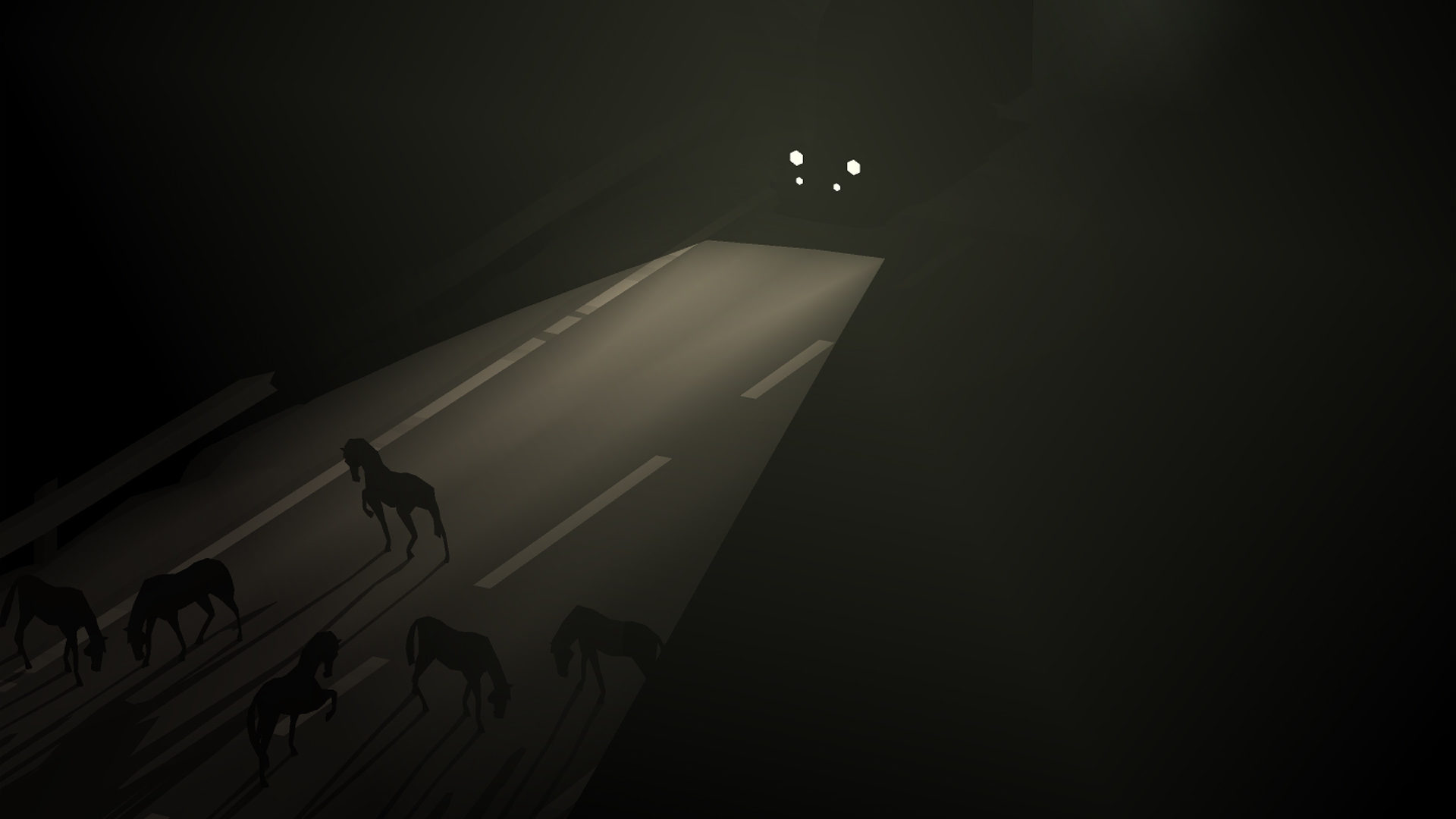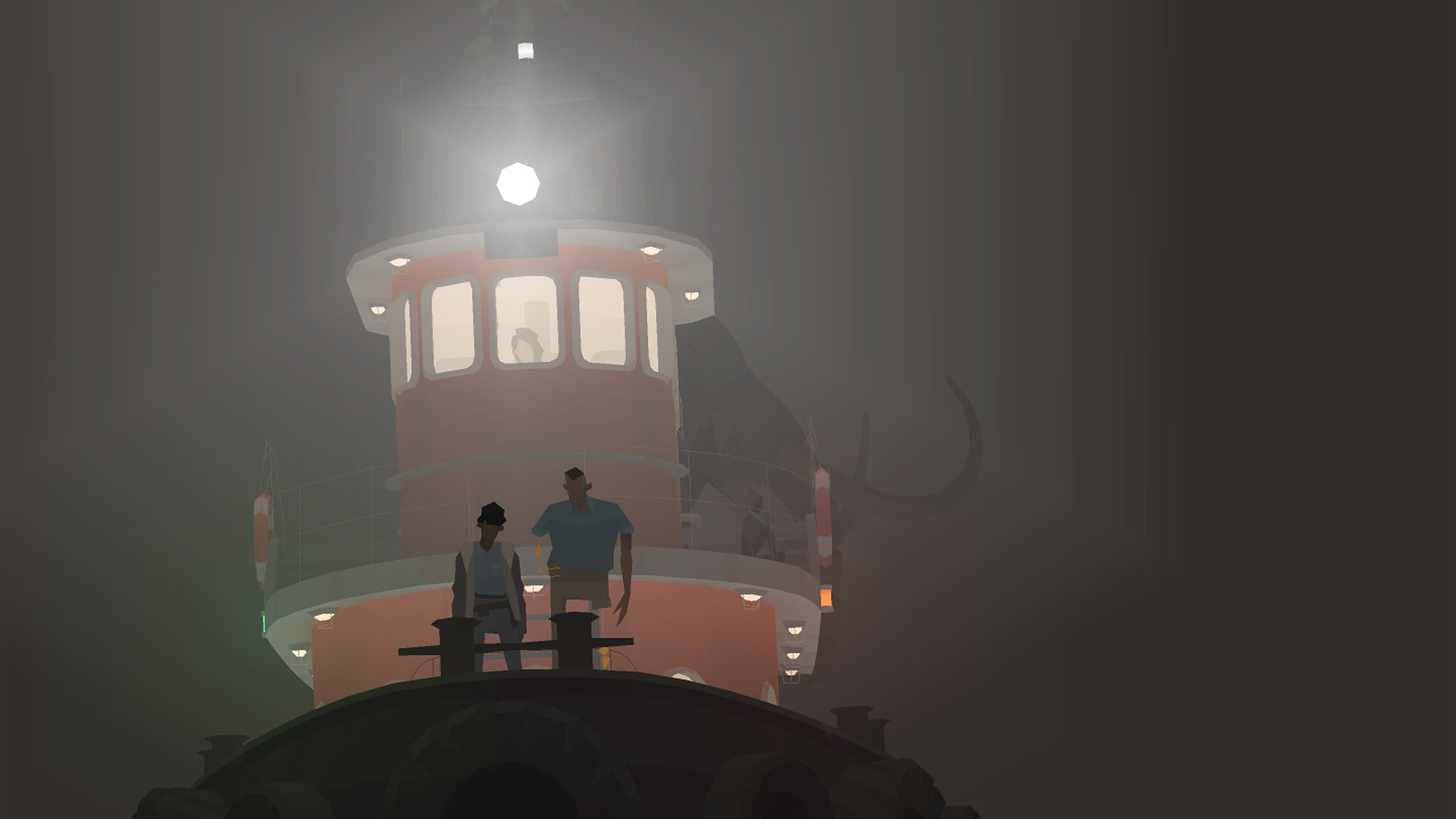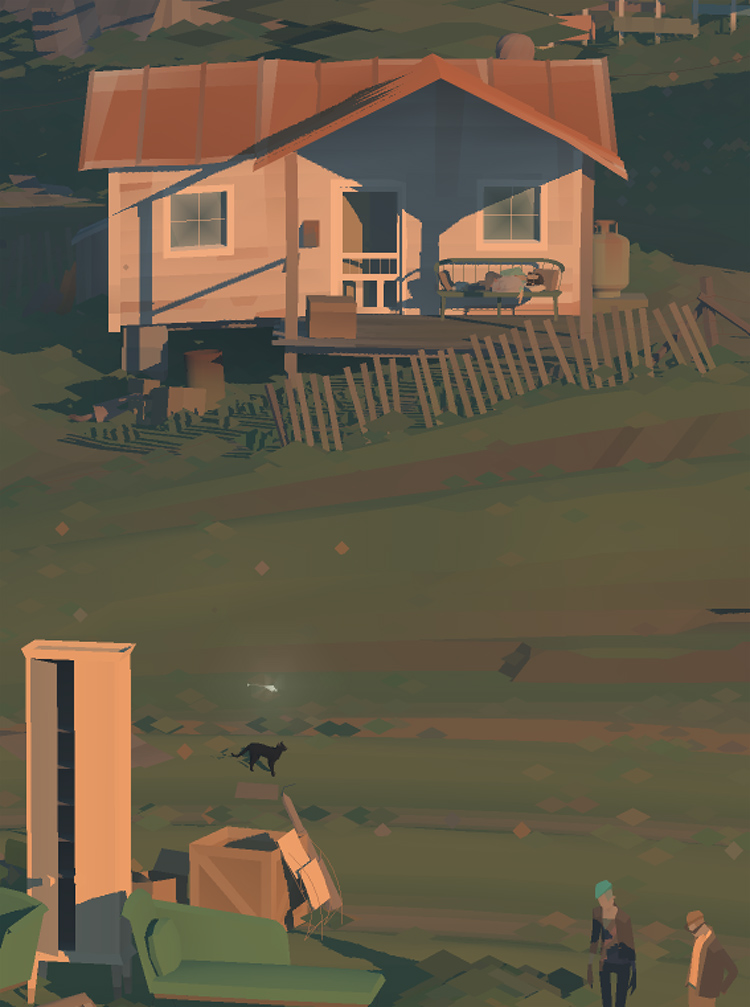Spoiler warning: This article contains images and descriptions of events from Kentucky Route Zero‘s final acts.
For one of the preeminent narrative games of the last 10 years, the critical consensus on Kentucky Route Zero seems to begin and end with the assertion that it’s a brilliant accomplishment. And I totally agree, though I’m not so sure that tells us much about the game itself. Part of the lack of clarity on the game, though, comes from the fact that, while some are experiencing Kentucky Route Zero for the first time in full right now, many people have long, complex histories of playing it piecemeal over a seven-year span.
I’m one of those people. I picked up and put down Kentucky Route Zero three times before finishing it, and the story of the game has evolved for me from a well-written but fairly standard indie game to a novelistic accomplishment. The evolution of my reception dovetails with the ways I’ve changed as a reader, too, and I don’t think I’m alone in changing the way I’ve approached games over that time. The recently released Act V of Kentucky Route Zero engages with the journey that both the game and its reception have traveled these past seven years, and in a final, literal funeral sequence, asserts that the game is, in the end, not an object of player reception, but a complete aesthetic object in its own right. In this way, Kentucky Route Zero gives its players closure, but in that closure shows that it is also a complete and consistent expression of an aesthetic vision through all of its disparate parts.

I first picked up Kentucky Route Zero in 2014 or 2015, though if you asked me to pin down the date, I don’t really think I could. Apropos of the game’s narrative, the twisting path of my experience with Kentucky Route Zero comes and goes in my memory—a flash of playing it on my laptop while my 1-year-old daughter was sleeping or while I was riding home from Chicago to the suburbs on the train, curled up in a hard plastic and worn fabric seat. I think I got a bit into Act II that time, petering out at the vastness of the Zero, the highway at the thematic center of the game, and its strange managerial partner, the Bureau of Reclaimed Spaces. My loose feeling about the game was that it was a beautiful slice of Americana, but I was never quite sure if its surrealistic flair landed (which in retrospect may have been me as a PhD candidate and a snob talking).
The next time I revisited the game, it was for a discussion with games writer and developer Scott Benson, who has long cited Kentucky Route Zero as one of the main inspirations for Night in the Woods. I restarted the game with this in mind, and found myself noticing elements of debt, income inequality, labor—issues that I wasn’t able or ready to see when I’d last played it a year or so prior. Act III had just been released, and while I did not finish the game completely, I was taken by Scott’s reading of the game as a tragedy, particularly his description of the debt that Conway, the game’s protagonist, finds himself in. The game changed again in my mind, from a LucasArts revival project to a focused critique, a story about accidents and payments when everything costs more than you have.
I meant to go back to the game again, but like a half-finished novel, the shape of its themes settled into the back of my mind, and I was totally comfortable with that. Kentucky Route Zero was, to me, a pretty well-written game about the ways that debt forms the experience of precariously employed people—like delivery drivers, TV repairwomen, miners, and ghosts. I’ll admit that I thought for a long time that the game was fine, but over-praised because of its literary motifs. I thought it was more pretense than content, and it took me until its full release to realize how wrong I was.
The full release of Kentucky Route Zero, in a convenient console package alongside its fascinating and, honestly, essential interstitial vignettes gave me as good a reason as any to replay the game, and I was surprised by the moving quality of the narrative. I knew the direction the game was going to take from the outset, and I even knew a lot of the beats it would use through its first two or three acts, and I still was caught off guard by details and notes I’d forgotten or missed the first time through. It took until I got to the Zero, in the middle of Act II, to realize that I’d started treating Kentucky Route Zero like a book as opposed to a video game: It wasn’t an adventure game in the spirit of LucasArts’ classic work, and it wasn’t an inelegant commentary on class that just took the form of a game. This was a story that was being told in its own embodied world, on its own terms, and on a trajectory that had very little concern with the expectations of its readers.

So what changed in the game? Why does it so forcefully project this kind of narrative cohesion when it seemed like a fairly standard indie game five years ago? The answer is that the game itself didn’t change as it progressed, but rather its acts built on one another and undercut expected narratives each time a new branch of the story was introduced. The release of Act V then allowed for the least expected and most resolute conclusion to the story possible.
I’ll try to avoid spoilers here, but if you’re worried about that kind of thing, I’d recommend playing the game through and coming back in five or six hours—the novella length of the game itself is an absolute selling point for anyone who wants to think through Kentucky Route Zero as an exercise in rereading. And I would certainly encourage rereading and replaying even if you just picked it up, because the subtext of the relatively traditional Act I foreshadows the themes of indebtedness and hopeless accumulation to follow. The slow search for the Zero, the subterranean highway Conway must travel on to deliver his package, traces its way through a defunct mine, a near-abandoned bait shop, an abandoned home and graveyard, and a gas station running on empty.

This foreshadowing pays off in Act II when the bureaucracy of the Zero is introduced in the form of the Bureau of Reclaimed Spaces. We meet Lula, the first instance of a side anecdote from a previous act producing a new character, and we are dropped into the surreal quality of the game in full, with the spaces like storage facilities reclaimed as churches and towns made into museums. This lack of permanence takes us through Acts III and IV, as well, as Conway is conscripted through a series of unavoidable acts into servitude and begins to lose his humanity. The game itself also takes autonomy away from the player, putting the entirety of the fourth act on rails as our characters get on a boat traveling down the Echo River.
The conclusion of Act IV—and this is a spoiler—has Conway joining the glowing skeletal servants of the Hard Times whiskey company, and vanishing from your party forever. And so we are left in Act V without our ostensible protagonist, at the destination of the delivery that propelled the game to this point. As the characters leave the Echo River and come up to ground again, they find themselves in the middle of a town that’s been flooded and destroyed, filled half with people about to leave, and half with ghosts that wander the waterlogged lawns. The player is now given control of a small dragonfly that lures a cat around to observe and interact with the people of the town and the party members in the game’s final moments.

This is the moment of the game where the player is most distanced from any sort of plot or autonomy to move the game’s story along. You’re forced to watch as a passive observer as the characters solve a now-seven-year-old mystery and find 5 Dogwood Drive. And as first a backdrop and then the meat of Act V, the town buries and holds a funeral for the town’s mascot-esque horses, The Neighbors. As the funeral goes on, the final moments of this closing act touch on togetherness, class issues, the death of industry, debt, and more, in a kind of eulogy to the themes of the game itself. In short, the final moments of Kentucky Route Zero are a farewell to the player, who is given a chance to mourn and give closure to this narrative, whether they’ve been a part of for six hours or seven years.
This final moment in the game felt reflective of my journey as a player, through every sort of reading of this elusive game. But unlike me, the game didn’t so much change or evolve as it unfolded—Kentucky Route Zero works so well because it maintains a singular focus throughout its five acts, more like a novel than a serialized adventure. In many ways it reminds me of Roberto Bolaño’s 2666, a novel that is made of five novellas that loosely connect but build upon each other thematically—a piece that is more than the sum of its parts. Much like this novel, the game is about the struggles we face when our lives are existentially determined by debt and the impossibility of repayment, but it’s also about space, and place, and belonging. The game is melancholic but not pessimistic; deeply American, but also reflective of a wholly imagined new space made up by the constellation of its characters.
Ultimately, Kentucky Route Zero asks you in its conclusion to reconsider everything you’ve played and think on it again and again—it asks you to reread it. There is then a sense of closure to the game as we know how it ends, but much like the way that our sense of reading and understanding video games is a continual work in progress, the game offers no true completion. The next step after beating Kentucky Route Zero is to think about Kentucky Route Zero. And the next step after that, as the circular act selection screen suggests, is to start again and reconsider what you know about the game.
This ability to be read but not finished is what makes Kentucky Route Zero an important game, and it took me three playthroughs just to get to that conclusion. Many games are literary, and many more are extraordinarily well written, but Kentucky Route Zero is the first game that, to me, demands interpretation on the level of a novel. It is a singular accomplishment, worth the time it took to get here.

All images: Annapurna Interactive, Cardboard Computer via EGM

Trevor Strunk is a recovering English PhD, teacher, podcaster, and dad who lives somewhere around Philadelphia. He talks about videogames with various guests on No Cartridge, a podcast that can be found where all good podcasts are provided, and occasionally writes at no-cartridge.net. You can follow his more transient thoughts @hegelbon on twitter. Oh and go play Outer Wilds, his 2019 game of the year!